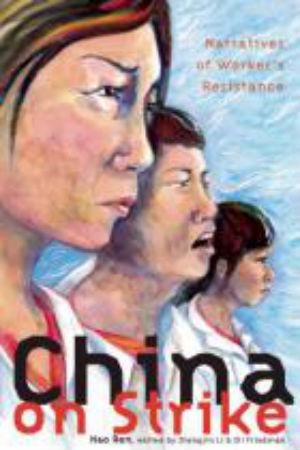
China on Strike gives in insights into Chinese workers’ struggles and the nature of capitalism in China, writes Orlando Hill

China on Strike: Narratives of Workers’ Resistance (Haymarket Books 2016), English edition edited by Zhongjin Li and Eli Friedman, xvi, 224pp.
China is portrayed in the media as a powerhouse. An economy with double-digit growth and a subservient working class whose only form of protest is to commit suicide by leaping off factory roofs.
As a counteractive to this picture, China on Strike is very welcome. The book is a series of stories collected in 2010-11 of workers’ struggles in the Pearl River Delta of Guangdong province. What struck me most about the stories is how disorganised capitalism is in China. One of clues that a firm is facing imminent closure is when the owner is spotted trying to remove machinery from the factory site while workers are still turning up for their normal shifts. Workers react by blocking the entrance gate and taking turns to guard it in order to stop the removal of the equipment and thus prevent further loss.
The stories were collected by Marxist-oriented university students who had gone to work in factories, either motivated by idealistic or economic reasons. The aim was to develop a more thorough understanding of the causes, processes and outcomes of the struggles. The primary causes of the strikes are industrial and derive from poor working conditions, including low and withheld wages, savage management and mandatory excessive overtime. The stories’ focus on migrant workers in Guangdong Province’s River Pearl Delta is particularly useful, as this region has been the most dynamic over the last thirty years, attracting more manufactures and more migrant workers than any other.
There are seventeen narratives that can be dipped into and be read in any order. They describe the imaginative and spontaneous tactics that workers come up with in their struggle for better working conditions. The actions are not normally restricted to the factories, but spread throughout the town as workers block roads and march to local government offices. Workers interviewed expressed their feeling of being pressurised, but also their excitement: ‘Suddenly they are rid of the daily drudgery, restraint, and humiliation, and by causing some trouble for their oppressors, the thrill of revenge and a rebellious spirit spontaneously arises’ (p.55).
The experiences of one strike would be be passed on by word of mouth and one factory would learn from another. That is what makes the experiences reported in this book so valuable. As capitalism spreads to the interior of China, worker unrest will follow and the lessons from Guangdong will be vital. The unrest will not just spread geographically, but also throughout other sectors, including ‘transport workers, teachers, street cleaners, retail workers and white-collar workers’ (p 221). The attempts from the central government to tame this insurgency have so far failed.
The team that worked in collecting the stories point out the increasing involvement of students and other allies. Solidarity has been expressed by other groups, who help in organising the collection of food, the distribution of bulletins, the gathering of petitions and helping with media outreach.
However, the workers face serious obstacles in their struggle. Local governments are closely allied with the interests of capital. The official unions remain undemocratic and largely ineffectual, and capital remains highly mobile. For example, during one strike, Adidas threatened to shift orders to Vietnam.
The insurgency among workers has generated an interest in labour and Marxist theory. Reading groups in Marxism have proliferated in university campuses. The book quickly touches on this, but I was curious to know more about the relationship between workers and Marxism in a country which is ruled by a political party that officially defines itself as Marxist-Leninist. Do the workers see Marxism as a useful theoretical tool in their struggle or is it dismissed as part of the ideological apparatus of the state? That is a question for another book.

